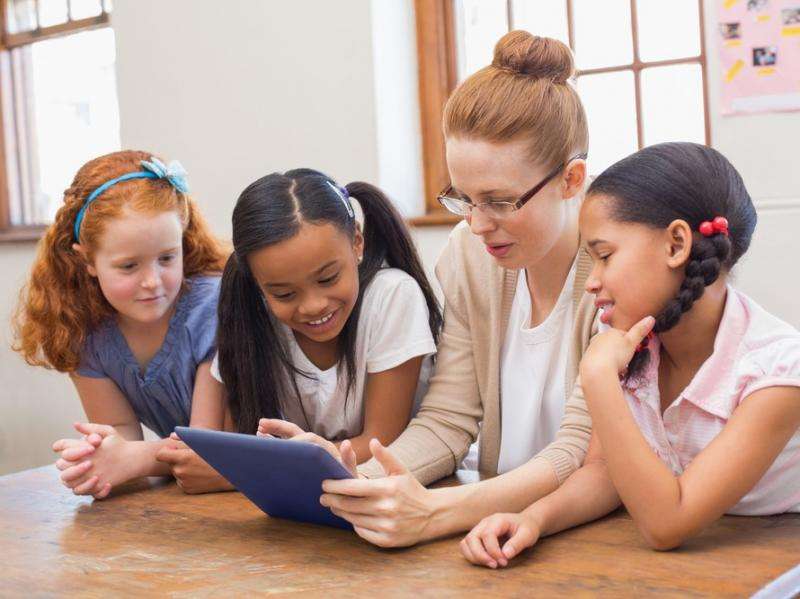Integrating technology in the classroom

Studies show that students succeed with digital learning, but making the transition from text book to tablet has its challenges.
As students across the country dive into a new school year, ready to hit the proverbial books, many find themselves swiping screens instead of flipping pages as districts ramp up tech programs.
Laptops, tablets, software and apps. These are the tools of learning in the 21st century, the paper and ink of the next generation.
These essential skills include communication, critical thinking, problem solving, collaboration, and, of course, digital literacy.
"Technology can be an invaluable tool for teachers to engage students and to enhance the learning process," says Paige Johnson, education strategist for Intel and an expert in guiding school systems along the technology adoption curve.
"However, it is critical that technology choices are based on well-defined learning goals and that teachers are provided with the necessary professional development effectively integrate digital learning into daily instruction."
Benefits of Effective Tech Integration
Kids are drawn to technology. Just try to pry a Nintendo or smartphone from any kid's vise-like grip.
Clearly, technology offers tremendous potential to engage students in learning.
Some benefits:
- Tech literacy: Students develop necessary skills for college and career readiness.
- Improved engagement: Technology helps students stay on task and improves attendance.
- Information access: Students have access to timely resources.
- Connections: Access to real-world. Tech devices and apps enhance hands-on learning.
- Communication/Collaboration: Students hone communication skills through varied media and engage in collaborative learning.
- Differentiated learning: Students with varied styles of learning find new ways to assimilate information and demonstrate learning.
- Distance learning: Students access outside educational content, such as Kahn Academy (instructional videos and practice exercises).
- Flipped classroom: Students watch instructional videos outside of class, using class time to practice new concepts while the instructor is there to help.
- Classroom management: Tools help teachers analyze student learning so they can adjust instruction quickly to address needs, as well as organize homework, assessments and grading.
Recognizing the significant gains that can be made through effective tech integration, school systems scramble to roll out new technology in their districts.

Putting the Laptop Cart Before the Horse
In recent years, some schools have had difficult to downright disastrous tech roll-outs, often because somebody started picking tech devices before considering how they might be used to support learning goals. Little thought was given to professional development for teachers, or how they were going to support all of the issues that naturally occur with technology, such as broken screens, connectivity issues or glitchy software.
According to those who've overseen successful ed tech initiatives, it is critical to develop a clear set of learning goals first, and then find the tools that support those goals.
"Work backwards from what you want to do," advised Casey Wardynski, superintendent of Huntsville City Schools, in Alabama, in a 2014 Q&A with Intel Education. "If what you think you want to do is just put a computer in a kid's hands, you have to ask yourself, 'And then what?'"
He said if the answer is to build an engaging learning environment full of useful resources, then that's a good starting point. "But if you start with the hardware and then try to figure out what you're going to do with it, you're probably going to find trouble."
Let Learning be the Guide
Wardynski and his team put this well-reasoned process—learning goals guiding all other decisions—to work in the rollout of a 1:1 tech initiative in Huntsville, an urban-rural school district with more than 23,000 students.
"We looked at what it takes for every teacher to succeed, and we worked to provide that so they could focus on moving ahead with the digital transformation," said Wardynski.
In 2012, the district gave tablets to students in Kindergarten through fourth grade and laptops to those in fifth. In 2013, they rolled out across the district, distributing laptops to sixth through 12th graders.
Despite a steep learning curve for all, positive results were soon evident.

Across the district, discipline problems and suspensions dropped 35 and 30 percent, respectively, as student engagement increased. While not surprising, when wireless internet access was added to school buses, discipline problems declined by 76 percent.
Over the next two years, graduation rates rose from 66 to 80 percent, with the schools that had the lowest engagement before showing the greatest improvement.
Huntsville educators also report that new tools have enabled them to better gauge instructional alignment with Common Core State Standards and to adjust professional development accordingly.
Evidence of Success
To see evidence of success over a longer timeframe, look at Klein, Texas. This district near Houston, with 48,700 students, launched a Technology Baseline Standard Initiative in 2004 to better engage students and embrace 21st-century learning.

The district trained teachers on how to effectively integrate technology into lesson plans, and provided tech specialists to support them through the adoption process. They even installed fix-it centers in each school so that PCs could be repaired on site.
Since the program's implementation, the district has used the Texas Assessment of Knowledge and Skills (TAKS) test to track improvement. Student achievement increased in all subject areas, with the biggest gains from economically disadvantaged students.
Clear Direction
When Huntsville embarked on their technology initiative, Wardynski compared it to crossing the Rubicon. The district even disposed of old textbooks to make it clear there would be no going back.
"Education is designed to prepare children for the world of college and then on into a career," he said. "The notion that we're going to do that without using technology is pretty crazy."
Provided by Intel



















